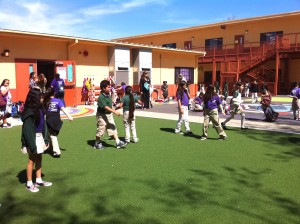The Rocketship network of charter Schools in San Jose is fairly new -- the first school just opened in 2007. But from an observer's perspective, a few lessons can be pulled from the way the young network has engineered the design of the school system. Can these ideas be applied to any school, whether they're charter, private, or traditional public school?
- THE CAMPUS IS ONLY THE SETTING. When it comes to school, innovation in the way a student learns lives in the circuitry of the way the day is designed. For a school that’s known as one of the pioneers of hybrid learning, the campus of Rocketship Mateo Sheedy is decidedly traditional. Classrooms, playgrounds, and the school’s office look like any other. In fact, I’d argue the campus is more modest than many I’ve seen. Students sit on the floor of the Reading Center for their individual reading times. The computers are sectioned off from the cafeteria with dividers. Students are squeezed next to each other on the only available seating in the lunch room. What makes it different is the inventive schedule that guides how and what students learn, making most of the educators’ time and effort. With all the discussions about the future school day, it turns out that it might actually not look so different than today.
- SMART, ADAPTIVE TECHNOLOGY IS KEY. Finding the “Holy Grail” of individualized learning when it comes to technology depends on how well the computer programs work with students’ learning levels. Rocketship administrators believe the ones they’ve chosen do the job. As spokesperson Judith McGarry described it, remediation happens seamlessly until each student is ready to move to the next level. Granted, these are fairly simple subjects in K-5 grades. The true test will come when or if it moves into middle school curriculum and beyond.
- SCHOOLS CAN DO MORE WITH LESS. Because a portion of students’ day is spent in the computer Learning Lab using the adaptive technology, hiring an extra teacher for that period is not necessary. The labs are monitored by teacher aides, who mostly answer questions and try to keep students focusing on their work.
- TEACHERS NEED TO BE VALUED. Offer professional development ideas, time and ways for them to collaborate, training in technology tools, and most importantly, value their ideas for what they want to bring to their own classes.
- KEEP TINKERING. Rocketship was co-founded by John Danner, a former software engineer who created the design of the school day. The team continues to iterate on the network’s system. They’re in the midst of creating a teacher’s dashboard that tracks students’ progress on the computer programs for teachers. They continue to adjust the schedule with each new idea and change and find new ways to improve depending on what works and the community’s feedback.
[module align="center" width="half" type="aside"]
Read more from the MY EDUCATION series:
- PART I: How Can An Advanced Student Move Ahead in Public School?
- PART II: Hybrid Learning Comes to Life at Rocketship
- PART III: Rocketship's Culture - Respectful, Empathetic and College-Bound
- PART IV: How to Keep Good Teachers in the Game
- PART V: Focus on Assessments Fuels Rocketship's Goals
- PART VI: A Look Inside Rocketship
- PART VII: Five Lessons Learned from a New Charter School
[/module]


